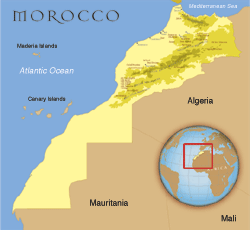|
This exhibition is the first of its kind presented at the National Museum of African Art to focus exclusively on the tradition of beautiful embroideries, textiles and jewelry from the Kingdom of Morocco, located in Africa's northwestern region. The 67 works presented here are selected from the Indianapolis Museum of Art's vast collection. The nucleus of that collection came from a gift to the Indianapolis Museum in 1933 from the Niblack family of their entire collection of textiles, which was accumulated from Morocco and other countries all over the world. 
Morocco's landscape consists of a fertile plain on the Atlantic coast and five mountain chains that dominate much of the rest of the country: the Rif Mountains, located in the north, and the Middle, High and Anti Atlas and the Siroua mountains that stretch north to south through the interior. In the winter, the mountains are snowcapped. Jebel Toubkal, part of the High Atlas range, is the highest peak in North Africa with an elevation of 4,165 meters (13,665 feet). Northern Morocco has a Mediterranean climate, with warm wet winters and hot dry summers. Farther south in the lowlands, the rainfall is less and temperatures are higher. Ocean currents cool the coastal areas.  At present, Morocco's population is estimated to number around 31 million. The majority of the population is Arab and Berber, and there is a Jewish minority. Arabs and Jews live mainly in the urban centers while Berber peoples tend to inhabit the rural areas. Islam is the predominant religion, and Christianity and Judaism are also practiced. Morocco's official language is Arabic. French is widely used as a second language in government and commerce, and Berber dialects are also spoken. 
|
||
|
Introduction | Urban Textiles and Costumes | Rural, Part One / Part Two | Education |
||
 Morocco, a country located in the northwestern region of Africa, is officially known as the Kingdom of Morocco. In the Arabic language it is called al-Maghrib, meaning "setting" or "west." It borders Algeria to the east, the Mediterranean to the north, the Atlantic Ocean to the west and the Western Sahara to the south. Morocco's total area is 710,850 square kilometers (274,461 square miles), making it slightly larger than the state of California. Rabat is the capital of Morocco and is the country's second largest city. Casablanca is the largest city, primary seaport and commercial and industrial center.
Morocco, a country located in the northwestern region of Africa, is officially known as the Kingdom of Morocco. In the Arabic language it is called al-Maghrib, meaning "setting" or "west." It borders Algeria to the east, the Mediterranean to the north, the Atlantic Ocean to the west and the Western Sahara to the south. Morocco's total area is 710,850 square kilometers (274,461 square miles), making it slightly larger than the state of California. Rabat is the capital of Morocco and is the country's second largest city. Casablanca is the largest city, primary seaport and commercial and industrial center. Half of Morocco's labor force is engaged in agriculture. The country's major crops are wheat, barley, corn, vegetables, sugarcane and an abundance of fruits. Cattle, sheep and goats are raised as livestock, and the Atlantic coast supports a fishing industry. Morocco is the world's third largest producer and exporter of phosphates, and coal, iron ore, zinc and manganese are also mined. Other industries include petroleum refining, food processing and the production of cement, textiles and chemicals.
Half of Morocco's labor force is engaged in agriculture. The country's major crops are wheat, barley, corn, vegetables, sugarcane and an abundance of fruits. Cattle, sheep and goats are raised as livestock, and the Atlantic coast supports a fishing industry. Morocco is the world's third largest producer and exporter of phosphates, and coal, iron ore, zinc and manganese are also mined. Other industries include petroleum refining, food processing and the production of cement, textiles and chemicals.